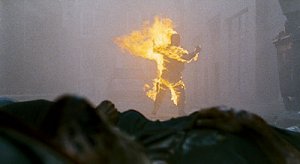28 Weeks Later
Saturday, October 24th, 2009 • Horrorthon Posts / Horrorthon Reviews
This movie diminished in my estimation with each passing scene, so that my prediction of the rating I would give slipped from four-star to three-star to two-star over the course of its (brief) running length. It’s too bad, because writer/director Juan Carlos Fresnadillo and the other filmmakers clearly wanted to follow respectfully in the footsteps of Danny Boyle’s vastly superior 28 Days Later (2002), and the ambitious seriousness with which they took on that task is worth celebrating and rewarding. Unfortunately, despite the tremendous care taken to extend the elements of the first movie without altering or diminishing them, the project is fundamentally ill-conceived and the resulting movie is a hopeless muddle.
The basic problem isn’t really anyone’s fault: the original story is too balanced, too complete; there’s no legitimate hook with which to build a sequel. 28 Days Later mimicked the structure of conventional zombie movies, but invented a clever “hard-sci-fi” alternative to the zombie mechanism itself: rather than walking undead, the ubiquitous ghouls were living people infected by a fictitious virus that generates the same zombie-like behavior (e.g. incoherence; attempting to eat everybody). The “RAGE” virus (created in a laboratory and accidentally released) spreads through the exchange of contaminated bodily fluids like a conventional infection, but does it quickly, so that anyone bitten or cut (or bled upon) by an infected person becomes an insane, blood-vomiting cannibal in a matter of seconds. Speed was the key concept behind most of the scenes in 28 Days Later; rather than silently lumbering around like George A. Romero zombies, Boyle’s “infected” sprint towards their victims en masse, screaming like banshees, to terrifying effect. (That’s my biggest problem with Weeks, by the way: with the exception of an excellent opening sequence, the movie just isn’t that scary.)
As any devotee of conventional zombie movies knows, zombies = end of the world; there’s no way to tell a zombie story without discussing the apocalypse, since there’s really no way to beat them (as octopunk put it, “the zombies get the upper hand and never lose it”). But the victims of the “RAGE” virus are different, and, as a result, Boyle’s movie has a (relatively) happy ending, in which the British military successfully contains the virus to the U. K., and the clear implication is that the world’s governments will help rebuild and repopulate Britain. The movie ends with what appears to be conclusive evidence of a competently-run aftermath, and a corresponding sense of finality. This is the big problem for the writers of Weeks: how to re-kindle a fire that’s basically been extinguished. What they came up with—this movie’s central idea—seemed vaguely promising as the movie began, but, as I said, it’s really just a card-house that collapses in slow motion, with the final cards dropping just as the movie ends.
The new story centers around a single nuclear family of survivors, who have been separated during the aftermath of the original “RAGE” crisis. Parents Robert Carlyle and Catherine McCormack are hiding in a remote farmhouse with a small group of survivors; their children (Imogen Poots and Mackintosh Muggleton) (those are the actual names) have been removed from the country according to plotting that I couldn’t quite follow, and are brought back to London much later as part of an American-led NATO military initiative to repopulate the city. In the movie’s opening sequence (and its only genuinely frightening scene) the parents’ fortified farmhouse is penetrated and attacked by “the infected,” and Carlyle (displaying the sort of horror-movie cowardice for which characters are always exquisitely punished) leaves his wife behind to perish and runs for safety. Seven months later (see the title) the children are reunited with their father (who keeps his shameful secret about abandoning their mother) in a Baghdad-style “green zone” within London that’s the foundation of NATO’s repopulation efforts.
But Mom is still alive, hiding in the family’s original London town house, and is discovered by the children when they escape the military perimeter and return there to gather their belongings. It takes the military a spectacularly long time to figure out where the kids have gone and to retrieve them, despite the fact that rooftop snipers with powerful telescopic scopes actually witnessed their escape. (Already, as I’m sure I’m making clear, the story is beginning to come apart; there’s just no way to justify any of this behavior.) The mother is medically unique: an Army doctor (the excellent Rose Byrne, who played the spacecraft pilot in Danny Boyle’s sublime 2007 sci-fi thriller Sunshine) discovers that she’s been bitten—she’s carrying the “RAGE” virus—but she’s somehow immune to its effects. This means that she (and, according to some tenuous medical logic, her children) are the key to discovering a cure for the virus itself, which would seem like a far more urgent goal if the spread of the infection hadn’t been successfully contained and neutralized in the first movie.
There are some intriguing procedural sequences surrounding the above events, including some reasonably diverting portrayals of extreme military operations against the unfamiliar backdrop of a modern Western city, but the card-house has already begun to fall apart. The filmmakers proceed to completely lose control of the story, so that the immediate, requisite escalation of fiascos (the virus begins to spread; the father and then the mother are lost; the security of the green zone is compromised; the military discipline breaks down; the power goes out; chaos reigns) is the result of every single character behaving in the stupidest possible fashion and of every surveillance and monitoring system in the city being ignored or overlooked. The intriguing family drama (the kids discover their father’s shameful secret) is tossed overboard immediately; new characters are introduced and summarily dispatched; the NATO forces appear to go insane and do everything the filmmakers can think of to make the situation worse.
None of this is remotely interesting or frightening, and the across-the-board failure of the movie to generate any suspense, fear or interest stands in marked contrast to the original movie, which is a masterpiece of horror in comparison. It’s fairly obvious that the disquieting, profound way that the Army discipline broke down into murderous fascism in the first movie (according to well-worn Danny Boyle themes) inspired the corresponding military screw-ups in this movie, but the idea is so nonsensically and arbitrarily employed that they really ought not to have even bothered; any intended social commentary is lost on the viewer. A great deal of work apparently went into creating this movie’s deserted London (frequently viewed from the air, or at night, or both, in order to emphasize its eerie, dark loneliness), but the effect isn’t nearly as unnerving and spooky as the comparatively modest, low-budget tricks used in the original movie. (Admittedly, part of the problem for me is that I’m simply not that familiar with the city; I thought I Am Legend was vastly more effective at the same task, but that may only be due to the fact that it showed my home town.) As I said, the completeness and finality of the original movie may have “boxed in” the filmmakers, preventing them from coming up with anything good to begin with, but I think that’s too kind: 28 Weeks Later is just inspired enough, just good enough in its fundamentals, that the vast disappointment of the movie is squarely the fault of Fresnadillo and the other filmmakers, who were halfway towards some good ideas and dropped the ball spectacularly.


